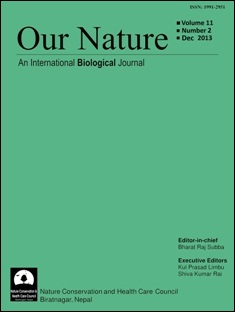Nitrogen and Phosphorous Budget Analysis of Carp Based Polyculture Ponds in Chitwan, Nepal
DOI:
https://doi.org/10.3126/on.v11i2.9535Keywords:
Nile tilapia, Sahar, carp, body weight, nutrient budget, ChitwanAbstract
An experiment was conducted in 12 earthen ponds of 200 m2 at Kathar VDC, Chitwan, Nepal for 270 days to analyze the productivity and nutrient budget in some carp based polyculture systems. The experiment was conducted in a completely randomized design with four treatments in triplicate each: a) Carps only or control (7000 fish/ha) (T1); b) Carps (7000/ha) + tilapia (3000/ha) (T2); c) Carps (7000/ha) + tilapia (3000/ha) + sahar (500/ha) (T3); and d) Carps (7000/ha) + tilapia (3000/ha) + sahar (1000/ha) (T4). Silver carp (Hypophthalmichthys molitrix), bighead carp (Aristichthys nobilis), common carp (Cyprinus carpio), grass carp (Ctenopharyngodon idella), rohu (Labeo rohita) and mrigal (Cirrhinus mrigala) of mean stocking size 3.0, 4.2, 10.0, 18.8, 10.5, 2.2 g, respectively were stocked in all ponds at the ratio of 4:2:1:1:1:1. The mean stocking size of Nile tilapia (Oreochromis niloticus) and sahar (Tor putitora) were 9.7 and 3.4 g, respectively. The ponds were fertilized weekly with urea and di-ammonium phosphate @ 4 g N and 1 g P/m2/day. Fish were fed with locally made pellet feed (20% CP) once in an alternate day at @ 2% body weight. At harvest, the extrapolated fish yield ranged from 1.5 to 1.7 t/ha/year in different treatments, without significant differences among treatments (P>0.05). Inclusion of sahar in Nile tilapia ponds decreased recruits by 63 to 72%. There were no significant differences in water quality parameters among treatments, except dissolved oxygen concentration, which was significantly lower in T1 and T3 than T2 and T4 (p<0.05). Both nitrogen and phosphorous were gained from fish species and lost from soil and water. There were no significant differences in nitrogen and phosphorous contents of all inputs and outputs among treatments. The unaccounted nitrogen and phosphorous loss ranged from 9.8-17.1% and 51.2-64.4%, respectively. The nitrogen and phosphorous required for producing 1 kg fish ranged from 337.5-375.9 g and 130.3-150.9 g, without significant difference among treatments. The nitrogen and phosphorous discharged for producing 1 kg fish ranged from 1.59-4.35 g and 1.6-9.3 g, respectively.
DOI: http://dx.doi.org/10.3126/on.v11i2.9535
Our Nature 2013, 11(2): 116-125
Downloads
Downloads
Published
How to Cite
Issue
Section
License
This license enables reusers to distribute, remix, adapt, and build upon the material in any medium or format for noncommercial purposes only, and only so long as attribution is given to the creator.




